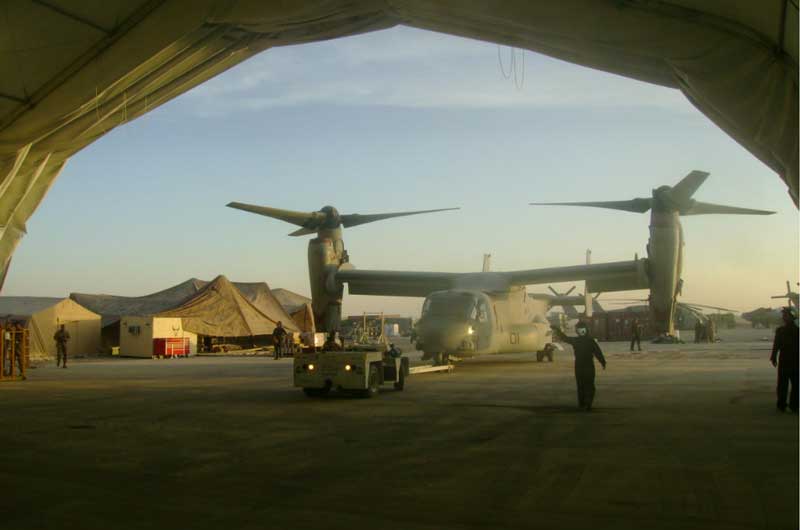The Osprey at the Five Year Mark: A Look Back in 2012
2012-08-31 by Robbin Laird
This September, the Osprey will reach a 5-year mark in its operational deployment history.
In September 2007, the Osprey was deployed for the first time to Iraq. The USMC Commandant Conway and Deputy Commandant of Aviation Castellaw announced and made the decision to deploy the Osprey into combat although virtually all public commentators thought this was too early for an “untested” airplane, as one critic put it.
The plane has not only done well, but in 5 short years has demonstrated its capability to have not only a significant impact on combat but t0 re-shape thinking about concepts of operations.
In this piece, I would like to reflect back on these 5 years, not just to grasp lessons learned, but glimmers of where the plane, and the USN-USMC team might well be able to move into the future.
The story of the evolution of the con-ops surrounding the plane provides a solid foundation for innovation and transformation of concepts of operations for the USN-USMC team, if boldness overcomes timidity.
In this regard, it is important to go back to the founders of the modern U.S. Navy who understood that one builds strategy around what is coming, not where one has been. One builds on F-35s and Ospreys, not F-18s and CH-46s.
As noted in an earlier piece on AOL Defense:
In 1924 a very accomplished Admiral grasped that action/reaction vision for the future
The President of the Naval War College overseeing these discussions (studying the complexities of British and German Fleet tactics during the Battle of Jutland in WWI) was none other than Admiral William S. Sims, who had already influenced King’s and Bill Halsey’s development of destroyer techniques, not to mention the convoy system. When Sims spread his war games fleet across the plotting board, he introduced aircraft carriers to the mix–even though Lexington and Saratoga were still months away from commissioning-and he argued that the aircraft carrier would replace the battleship as the navy’s capital ship. The reason was that carriers presented a 360-degree range of firepower via their aircraft that far outdistanced the radius of a battleships’ guns.
Sim’s fixation with a widening circle of projected power may have influenced Nimitz’s fellow classmate-both at Annapolis and now at the Naval War College-Commander Roscoe C MacFall when he took his turn at the plotting board. Rather than placing his ships in long lines, MacFall arrayed his fleet in concentric circles around his capital ships-admittedly still battleships. The tactical advantage was that with a common pivot point in the center of the circle, all ships could turn together and remain in formation.
(Page 131 The Admirals by Walter R. Borneman, May 2012)”
Each year for the past 4 years, I have driven down to New River Air Station and interviewed pilots and logisticians for the Osprey.
As a result, I have had the opportunity to hear from the operators what they are doing and what they have learned during this roll-out period. This year was no different and I had the opportunity to sit down with three experienced pilots and leaders in what is called the “Osprey Nation,” or the growing group of young aviators and maintainers who form the nucleus of the future of the USMC and of power projection.
We can start first with the decision of USMC leaders to deploy the plane to Iraq.
This deployment was itself part of the “testing” process. What is often overlooked is that testing is really done by pilots and maintainers in combat, not by technicians in white coats or statisticians at the GAO. There was clear concern expressed to me by Marine Corps Aviators that the deployment to Iraq would prove challenging, and its was. But it was also evidence of the role of leadership in making the hard decisions to role out needed capabilities and let the users define the direction of a program, not the program managers.
The deployments have been on land – Iraq and Afghanistan – as well as at sea. The plane and its crews have been tested in combat and in real world operations.
What we have seen is that the plane started with “training wheels on” its deployments, and those wheels not only have been thrown off, but as time in combat has gone up, the Marines as well as the Combatant Commanders have begun to understand what a transformational platform can do when connected with other capabilities and assets.
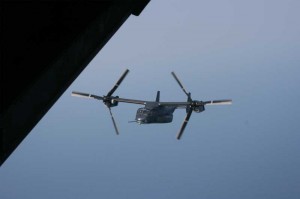
The plane started in Iraq built around a famous diagram showing the speed and range of the aircraft in covering Iraq. As one Marine commented: “The MV-22 in the Area of Operation (AO) was like turning the size of the state of Rhode Island into the size of Texas.”
It was the only “helicopter” that could completely cover Iraqi territory. And in this role, the testing of support as well as operational capabilities was somewhat limited as Marines tested out capabilities and dealt with operational challenges. The plane was largely used for passenger and cargo transport in support operations in difficult terrain and operating conditions.
It was used for assault operations from the beginning but over time, the role would expand as the support structure matured, readiness rates grew and airplane availability become increasingly robust.
From the beginning the aircraft impressed and foreshadowed later developments. As General Walsh, now Deputy Commanding General Marine Corps Combat Development Command noted in an interview at the Cherry Point Air Station in 2009 after a year in Iraq that with the withdrawal of US forces from Iraq there was a roll up of forward operating bases.
This meant that the remaining forces had to cover more ground and to provide protection at greater distance.
Enter the Osprey, which did not require FOBs to provide lift and support to forward deployed forces.
Indeed, General Walsh underscored that as the US forces withdraw, there was demand for more – not less – airpower.
This happened on several levels.
On one level, this was due to the drawdown of the number of combat posts, which supported operations in Iraq. American forces continued to work with Iraqi forces but now had to commute from distance to do their work, rather than being in close proximity to combat posts. This meant that airpower had to provide regular support to the transit of US forces working with Iraqis. “At one point we had 140 combat posts; while we were there we went from 36 to 4 combat posts; so air was relied on more frequently for convoy protection. As we drew down combat posts and associated capabilities, air was relied on for capabilities which had earlier been largely provided by the ground forces.”
On another level, this was due to the need to protect the convoys moving equipment out of Iraq. “”As you close down and do retrograde, you have to move further out in road miles and that requires air support.”
In addition, transport needs to move support elements to work with Iraqis increased demands for air transport. “We were increasingly asked to provide support for partnering operations.”
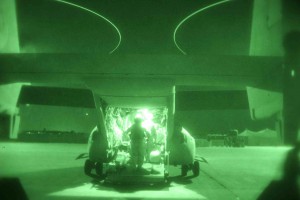
Iraq was the beginning and a consciousness raiser for troops and commanders.
One story told to me in 2010 by a battle-hardened Marine was as follows:
Major Lee York: We took some soldiers out to the West of Iraq. The crew chief comes up to us and tells us that the guys won’t get out of the plane. We’re like, what are you talking about? They said we’re not there yet. And we said, “What are you talking about?” He then said, “The last time we did this flight it took an hour and a half. We’ve only been in the plane for 40 minutes so we can’t be there yet.”
“The last time we did this flight it took an hour and a half. We’ve only been in the plane for 40 minutes so we can’t be there yet.”
We told him to tell the Marines that “we were cruising at 230 rather than at 120 so we were there. I swear we’re here, you know, we’re not going to send him somewhere where he is not supposed to be.”
Next on the agenda was the beginning of deployments to Afghanistan, which of course continue.
The Afghan phase of deployments has seen the aircraft and its operator’s transition to more assault combat operations over time, to the point where the latest Osprey squadron just came back from Afghanistan with record setting assault operations for the Osprey.
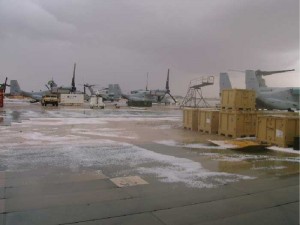
A metric to measure the transition can be seen in the number of named operations the Osprey squadron participated in in Afghanistan. Over time, the Osprey squadrons have significantly increased their involvement in what the military calls Named Operations, and these operations are air assault operations in support of U.S. and coalition forces. The latest squadron VMM-365 (the Blue Knights) conducted nearly 200 named operations, which was a 20-fold increase over the squadron which preceded it in Afghanistan.
In the words of the head of 2nd Marine Air Wing – Major General Glen Walters — upon his return from Afghanistan:
The Ospreys had their normal fair share of general support, resupplies, etc. But we started accelerating their use as my time there went on, and used them for both the conventional and Special Forces operations.
The beauty of the speed of the Osprey is that you can get the Special Operations forces where they need to be and to augment what the conventional forces were doing and thereby take pressure off of the conventional forces. And with the SAME assets, you could make multiple trips or make multiple hits, which allowed us to shape what the Taliban was trying to do.
The Taliban has a very rudimentary but effective early warning system for counter-air. They spaced guys around their area of interest, their headquarters, etc. Then they would call in on cell or satellite phones to chat or track. It was very easy for them to track. They had names for our aircraft, like the CH-53s, which they called “Fat Cows.”
But they did not talk much about the Osprey because they were so quick and lethal.
And because of its speed and range, you did not have to come on the axis that would expect. You could go around, or behind them and then zip in. We also started expanding our night operations with the Osprey. We rigged up a V-22 for battlefield illumination.
A lot of these mission sets were never designed into the V-22 but you put it into the field and configure it to do the various missions required. And we have new software for the Ospreys in Afghanistan where you can pick your approach, angle, approach speed and let the aircraft do it all. That is a huge safety gain.
The start of this transition to a tip of the spear air assault capability was seen at the beginning of the Osprey’s deployment in Afghanistan.
In a phone interview, which I conducted with the Osprey squadron commander in early February 2010, the evolving role was evident.
According to Lt. Col. Bianca, the Osprey squadron commander:
Here is something that no one ever thinks about until one gets here. It is one thing for me to do an assault support mission where I insert troops to a location. It is quite another to talk about distributed operations.
In other words, if I am here at this airport, the troops I have to move are way over there, and the place I got to get them to is way over that way and if you want to do this in one cycle of darkness, you are going to have to put some speed on it, or you are going to have to make this a two-day evolution to move the troops here, and then get them there, so that you can do the mission.
You cannot lose sight of that either. So, even if it was to be characterized very placidly as “ferrying” of troops, there is that speed component. Football is a game of inches: combat is a game of minutes or even seconds, and that can matter.
From the distributed angle, never forget that the troops just get on the airplane here at Camp Leatherneck: they are not here at Camp Leatherneck; they are always somewhere else.
We have to go there first and then, move them to wherever the operation is going to go. And whatever one’s characterization of the operation – whether it is an assault or a town meeting -, it is time-urgent mobility.
We are moving folks to places in this country that you just cannot get to in a timely manner any other way. You simply cannot. You cannot get in a car and drive there. You can get in a helicopter and fly there, but that is going to take you two and a half or three hours. Your only option is to get into a V-22, because “I got to get to that corner in the open world, – no roads, nothing there -, we got to go do it”, and that, then, becomes our mission.
See also:
http://sldinfo.com/mv-22-in-afghanistan/
http://sldinfo.com/vmm-261-inserts-troops-into-marjah/
Next up, was the challenge of understanding what the Osprey brought to the fight seen from the perspective of the USN-USMC team.
The plane was clearly not a rotorcraft; it was not a replacement for the CH-46.
But it took a while for the concepts of operations to change and commanders to understand fully that they did not have to operate in a fairly constricted operational box of a couple of hundred miles for the ARG-MEU and could think about a 1,000 plus operational area.
As one Marine described the transition and the challenge to adapting to what the Osprey can do with fast jets:
The speed and range of the aircraft is a game changer. But it’s the endurance of the aircraft itself. Basically you might say once it’s flying, it’s flying. And we had a lot of missions that required flight time above six hours, which is very taxing for the jet guys and for us, it is as well, but maybe not so bad because we can trade off in the cockpit. The fact is that you can have airborne assets, both as a package as well as a trap for sensitive site exploitations, being airborne all at the same time for hours at a time to respond to something that happens in the AOR. It will give you the maximum flexibility for response time down to something like thirty minutes, depending on where it is. And then sanitize the scene from there and then everybody returns home. It’s a capability that I’m not going to say it’s been overlooked but it just hasn’t been utilized like that.
We just didn’t really have that capability before, especially on much longer ranges and in sort of response time. So by marrying those two, the fixed-wing aviation asset we can do operations differently. We could neutralize a target and then you can immediately have a strike team insert to confirm that whatever happen, happened, give whatever materials they need, get back on an aircraft and leave in under thirty minutes in any location that we’re operating on a 600-mile ring. This is just so amazing for me.
Enter Libya and linking the Osprey to the USN-USMC Gator navy opened up a whole new capability.
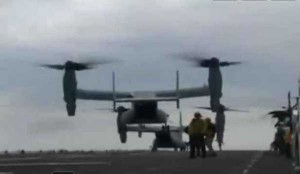
The Gator navy began its transition from Greyhound Bus to a new strike force capability.
The ability to link seamlessly support services ashore with the deployed fleet via the Osprey allowed the Harriers aboard the USS Kearsarge to increase their sortie rates dramatically. By providing a whole new speed and range enablement of the strike fleet aboard a large deck amphibious ship, the future was being re-defined by the Osprey.
As Lt. Col. Boniface, commanding officer of VMM 266, but the Osprey leader in Operation Odyssey Dawn, argued:
A complete transformation to how we are doing business has been involved by operating the Osprey. In order for the USS Kearsarge, the ARG and the 26th MEU to stay in their operational box during Operation ODESSEY DAWN, and enable the Harriers to continue their strike mission, we were reliant on other assets to supply us. For many supply items, the Osprey provided the logistical link to allow the ARG to stay on station and not have to move towards at sea re-supply points and meet re-supply ships.
Without the Osprey you would have to pull the USS Kearsarge out of its operational box and send it somewhere where it can get close enough to land or get close enough to resupply ships to actually do the replenishment at sea. Or you would be forced to remain where you are at and increase the time you’re going to wait for this part by three, four days or even a week.
The ARG ships are only moving at 14-15 knots. At best, let’s just say they move an average of 13 knots per hour, and add that up for the 300 miles that you have to sail. Now you’re looking at least a day to get the needed folks, parts or equipment and then the transit time back to the operational box. The V22 will do that in a couple hours and allow the ARG/MEU to keep executing its mission.
And now fast forward to Bold Alligator 2012, the largest amphibious exercise held since 1996.
A major difference from 1996 to 2012 was the appearance of the Osprey. Indeed, the existence, deployment and appearance of the Osprey changed the entire approach to thinking about amphibious assault.
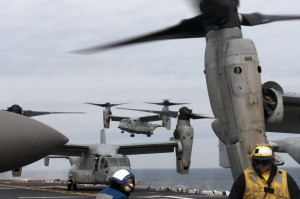
While observors stood on the beach waiting for the assault, Ospreys were already part of taking an “enemy” fort deep in the terrain. And not only that but one of the Ospreys deployed from a supply ship!
Prior to commenting on where the dynamics of change may move forward in the near to mid-term, it should be noted the path whereby innovation has occurred. It takes time, as one Marine told me. The Marines built up over this 5 year period a significant and growing number of member of the “Osprey Nation” and these folks then generated further capacity to learn and change. Not Inside the Beltway but on the battlefield.
Moving forward, using a term I used in the Bold Alligator piece, we can see glimpses of the future, which could lead to a cascading of change in operational approaches and capabilities if leadership will allow.
I would mention three prospects for change.
First will be the impact of the “self-deployment” capability of the Osprey. The Osprey is able to with tanking fly directly to the area of operation. Try doing that with a helicopter. In fact, self-deployment is now being used in bringing Ospreys back from Afghanistan and used regularly in exercises.
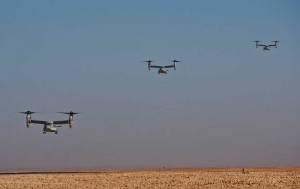
Self-deployment means that there is a possibility of rethinking how the seabase can work with land-based air.
Ospreys can move with the fleet, but be reinforced from land based Ospreys in plussing up air assault capabilities.
Second is the impact of a new system like the Osprey on removing problems, which threaten our warriors. There is a significant dimension to combat, which can refer to problems avoided because of the performance and reliability of the new systems. The Osprey has avoided strikes, which would have taken down CH-46s whether from manpads, RPGs or other weapons fire. The Ospreys have proven robust in combat, where aircraft damaged by ground fire have used their digital management systems and redundant systems to self correct and like the Timex watch ad, keep on ticking.
Old equipment is just that and puts warriors in harms way. I don’t see the Inside the Beltway people flying Caravelles but that is what we are asking our warriors to do way too often.
Third, the coming of the F-35B to the fleet coupled with the Osprey is a significant game changer. It will lead in the words of Lt. Col. Boniface, to a “Tsunami of Change.”
I sort of think of it like a game of chess. I think of a traditional or legacy ARG-MEU as being able to move a pawn one space at a time towards the enemy. If you have ever played chess it sometimes take a while to engage your opponent. We now have the ability to move a knight, bishop, or rook off of this same chess board and attack 180 degrees towards the rear of our enemy. We can go directly after the king. Yes, it’s not really fair, but I like that fact. The speed, range, and don’t forget the reliability of the MV-22 allows me to do this.
We talk about staying ahead of the bow wave.
Well there is a tsunami of change coming when we talk about the ability to fight an enemy and to support Marines ashore.
We can increase our area of operations (AOR) exponentially because we can spread out our ships; now we have an aviation connector that can move Marines a tremendous amount of distance and in a very short amount of time. We can also use this capability to leverage our other aviation assets like our AV8-Bs, CH-53’s, AH-1Ws and UH-1Ys to support the MAGTF and ultimately damage the enemy’s will to fight. Let’s not just move 50-100 miles ashore, but let’s move 200-500 miles ashore, and do it at an increased speed, range and lethality.
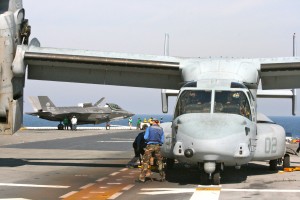
An earlier version of this piece appeared on AOL Defense.

